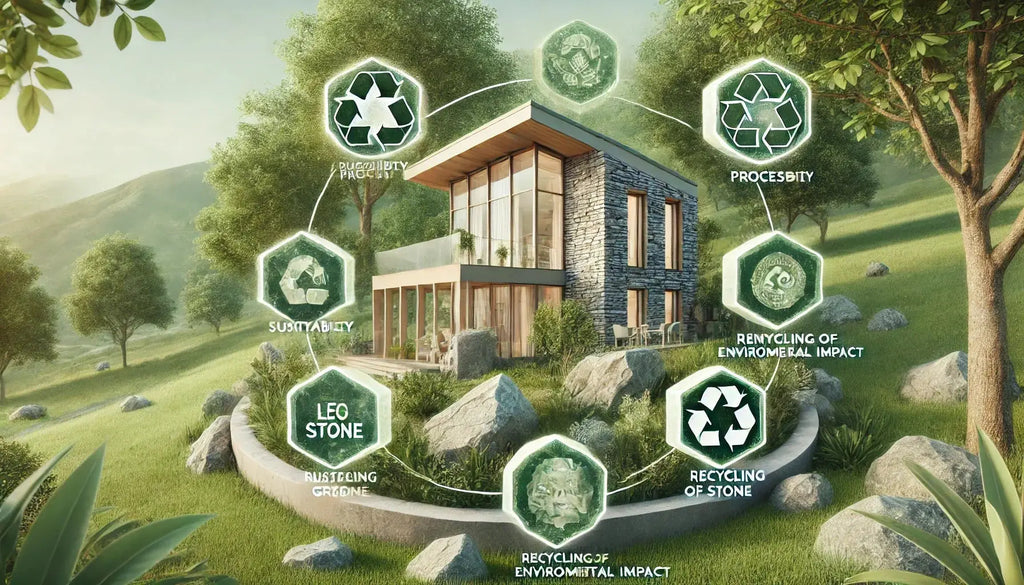Eco-Friendly Building Materials: Why Natural Stone is a Sustainable Choice

As the world moves toward more sustainable living, the demand for eco-friendly building materials is at an all-time high. While synthetic materials have dominated the construction industry for decades, natural stone is making a comeback due to its sustainability and environmental benefits. From marble and travertine to limestone and granite, natural stone offers a long-lasting, environmentally friendly alternative to mass-produced building materials.
In this article, we’ll explore the reasons why natural stone is the ultimate green building material and how it can enhance your home’s beauty while minimizing its environmental footprint.
1. Natural Stone: A Renewable and Abundant Resource
One of the biggest advantages of natural stone is that it’s a naturally occurring material. Unlike man-made products that require energy-intensive manufacturing processes, stone is quarried directly from the earth. Whether it’s marble, granite, or travertine, these materials are abundant and renewable resources that can be extracted with minimal impact on the environment.
- Carrara marble and Calacatta marble come from sustainable quarries in Italy, while travertine and limestone are sourced from regions like Turkey and Mexico, where quarrying practices have been honed for centuries.
- The natural formation of these stones means they don’t deplete finite resources, making them an ideal choice for environmentally conscious homeowners and builders.
2. Minimal Processing = Lower Carbon Footprint
Unlike synthetic materials like porcelain, vinyl, or laminate, natural stone undergoes minimal processing before it reaches your home. Marble slabs, travertine tiles, and granite countertops are simply cut and polished, preserving their natural beauty while reducing the energy needed for production.
- The energy saved by avoiding chemical processing and intensive manufacturing results in a significantly lower carbon footprint.
- Additionally, natural stone can be recycled and repurposed in future projects, extending its life cycle and further reducing waste.
3. Durability: Built to Last for Generations
Another key factor that makes natural stone an eco-friendly choice is its longevity. Materials like marble, granite, and travertine are incredibly durable, often outlasting synthetic alternatives by decades, if not centuries.
- Marble flooring and travertine pavers can withstand heavy foot traffic and weather conditions, making them ideal for both indoor and outdoor spaces.
- With proper care and maintenance, natural stone surfaces can last for generations, reducing the need for replacements and the environmental impact associated with frequent remodeling.
By choosing long-lasting natural materials like marble and travertine, homeowners can significantly reduce their contribution to landfill waste over time.
4. Local Sourcing Reduces Environmental Impact
The sustainability of natural stone extends beyond its durability. Many natural stone quarries are located close to major markets, reducing the need for long-distance transportation. By sourcing locally quarried stone, you can minimize the carbon emissions associated with shipping materials over long distances.
- Granite from domestic quarries in the U.S. and travertine from Mexico or Turkey can often be found locally, helping to reduce fuel consumption and greenhouse gas emissions.
- Locally sourced stone also supports the local economy and ensures that quarrying practices adhere to environmental and safety regulations.
5. Energy Efficiency: Natural Insulation Properties
Many types of natural stone, such as marble and limestone, have excellent insulation properties, which can improve the energy efficiency of your home. Marble tiles and stone walls can help regulate indoor temperatures, keeping homes cooler in summer and warmer in winter.
- Travertine pavers and marble flooring stay naturally cool, making them ideal for hot climates where reducing air conditioning use is a priority.
- Similarly, stone walls offer excellent heat retention, reducing the need for additional heating during colder months.
This natural temperature regulation reduces energy consumption, leading to lower utility bills and a reduced carbon footprint over time.
6. Environmentally Friendly Quarrying Practices
Sustainable quarrying is an important aspect of the natural stone industry. Many quarries around the world, particularly in Europe and North America, adhere to strict environmental guidelines that focus on reducing waste, conserving water, and restoring ecosystems after quarrying is complete.
- In Italy, for example, quarries producing Carrara marble and Calacatta Gold marble follow eco-friendly practices, including water recycling and minimal use of explosives.
- Quarries that produce travertine in Turkey and Mexico have also adopted sustainable practices to ensure the long-term viability of the stone and its surrounding environment.
7. Recyclability and Reusability
One of the greatest advantages of natural stone is its ability to be reused or recycled. Unlike many synthetic materials that end up in landfills, natural stone can be repurposed in new projects, giving it a second life. Whether it’s using reclaimed marble from old buildings or repurposing travertine tiles for outdoor landscapes, the recyclability of natural stone further enhances its sustainability.
- Leftover marble or granite slabs can be used for small projects like backsplashes, wall panels, or even decorative accents.
- Old stone pavers can be used to create beautiful garden paths or outdoor seating areas, making natural stone a versatile material that can last for centuries.
8. Aesthetic Value Meets Sustainability
Beyond its environmental benefits, natural stone is also valued for its timeless beauty and versatility in design. Unlike man-made materials that can quickly go out of style, natural stone brings a sense of luxury and permanence to any space.
- White marble like Thassos or Bianco Carrara creates a classic, elegant look in kitchens and bathrooms, while travertine pavers add rustic charm to outdoor patios.
- The aesthetic value of natural stone often increases the resale value of homes, making it both a financially and environmentally smart investment.
Conclusion: The Sustainable Choice for Modern Homes
In a world where sustainability is more important than ever, natural stone stands out as the ultimate eco-friendly building material. Its durability, minimal processing, recyclability, and energy efficiency make it a superior choice for environmentally conscious homeowners and builders. Whether you're designing a modern kitchen with marble countertops or creating a sustainable outdoor patio with travertine pavers, natural stone allows you to embrace both luxury and sustainability in one timeless material.


Leave a comment